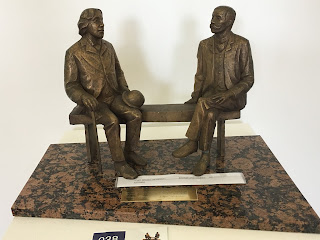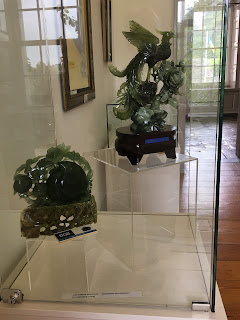The day started off in an interesting way. The bathroom shower was a tub/shower combination. I decided I would turn the water on before removing my nightgown and getting into the tub. I don't consider that to be an unusual thing to do--I always ensure the water is neither scalding hot nor unpleasantly cold before I get under. Well, I turned the water on and the shower became like a snake, writhing from one side of the tub to the other and drenching me and the bathroom in the process.
I turned it off quickly and tried tightening it on the pole. No luck--it wouldn't tighten. So I managed to take a "hand held" shower but it put paid to my review of Finnstown Castle Hotel.
Breakfast was okay though and we were on our way by 9:30 a.m. We have a brochure for top attractions in Ireland and we decided we would see three that day: Boyle Abbey, which was 169 kms (a 2-hour drive according to Google maps) from Dublin, thence to Sligo to see the Abbey and Cathedrals, another 42 kms, half-hour drive. Our final destination that day was in Gweedore, County Donegal, 138 kms but a 2-hour drive according to Google Maps. We hoped to be able to stop in Donegal itself on our way to Gweedore but it turned out to be too difficult to get to from the road we were on.
The M road was very easy to drive, very pleasant. There were two tolls on it but we have learned to carry change. We passed through several counties so I think we can say we are close to have "visited" all of the counties of Ireland now. We arrived in Boyle at around 11:00 a.m. Boyle itself is a very nice little town, located in County Roscommon and famous for the Battle of Curlew Pass where a band of Irish lads led by Red Hugh O'Donnell routed an English force in 1599. The area suffered very badly during the Famine. We learned most of this history during our visit to King House, a Georgian manor house that was owned by the wealthy King family (English of course) between 1720 and 1810. It fell into neglect and has been a restoration project since 1987 by Roscommon County Council. They have done a beautiful job and there are several excellent dioramas that outline the history of the Kingdom of Connaught, the history of the King family and a very sad room devoted to the role of the Connaught Rangers in World War 1. What I found particularly interesting was an exhibit of gifts that had been given to a former President of Ireland, Mary McAleese, from various countries.
Boyle Abbey was also very interesting. It's another Cistercian Abbey, built around earlier monastic ruins from the 10th century. The monks were not a wealthy order and it took a very long time to complete the abbey, in the 13th century. The Elizabethans turned the Abbey into a barracks in the 16th century and the Cromwellians besieged it in the 17th century.
The ruins are still impressive though, with several very interesting carvings on the pillars. We were given information sheets that helped draw our attention to little carvings that we might have missed.
On to Sligo next!!
I turned it off quickly and tried tightening it on the pole. No luck--it wouldn't tighten. So I managed to take a "hand held" shower but it put paid to my review of Finnstown Castle Hotel.
Breakfast was okay though and we were on our way by 9:30 a.m. We have a brochure for top attractions in Ireland and we decided we would see three that day: Boyle Abbey, which was 169 kms (a 2-hour drive according to Google maps) from Dublin, thence to Sligo to see the Abbey and Cathedrals, another 42 kms, half-hour drive. Our final destination that day was in Gweedore, County Donegal, 138 kms but a 2-hour drive according to Google Maps. We hoped to be able to stop in Donegal itself on our way to Gweedore but it turned out to be too difficult to get to from the road we were on.
The M road was very easy to drive, very pleasant. There were two tolls on it but we have learned to carry change. We passed through several counties so I think we can say we are close to have "visited" all of the counties of Ireland now. We arrived in Boyle at around 11:00 a.m. Boyle itself is a very nice little town, located in County Roscommon and famous for the Battle of Curlew Pass where a band of Irish lads led by Red Hugh O'Donnell routed an English force in 1599. The area suffered very badly during the Famine. We learned most of this history during our visit to King House, a Georgian manor house that was owned by the wealthy King family (English of course) between 1720 and 1810. It fell into neglect and has been a restoration project since 1987 by Roscommon County Council. They have done a beautiful job and there are several excellent dioramas that outline the history of the Kingdom of Connaught, the history of the King family and a very sad room devoted to the role of the Connaught Rangers in World War 1. What I found particularly interesting was an exhibit of gifts that had been given to a former President of Ireland, Mary McAleese, from various countries.
 |
| King House had also been a jail in the 19th c. This exhibit startled the bejeebers out of me. |
Boyle Abbey was also very interesting. It's another Cistercian Abbey, built around earlier monastic ruins from the 10th century. The monks were not a wealthy order and it took a very long time to complete the abbey, in the 13th century. The Elizabethans turned the Abbey into a barracks in the 16th century and the Cromwellians besieged it in the 17th century.
The ruins are still impressive though, with several very interesting carvings on the pillars. We were given information sheets that helped draw our attention to little carvings that we might have missed.
On to Sligo next!!
























Comments
Post a Comment